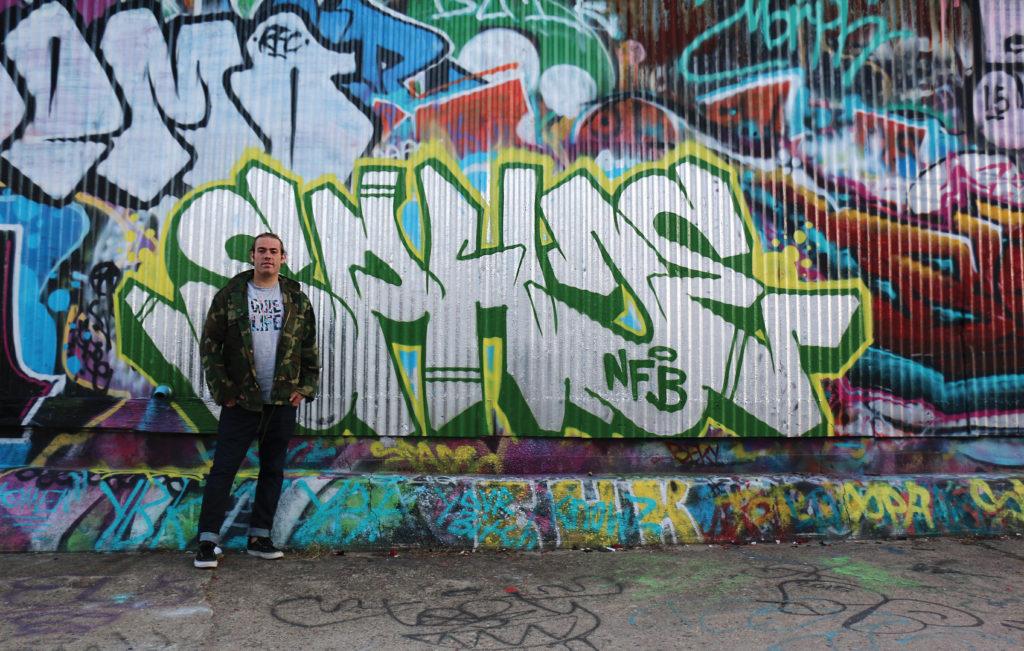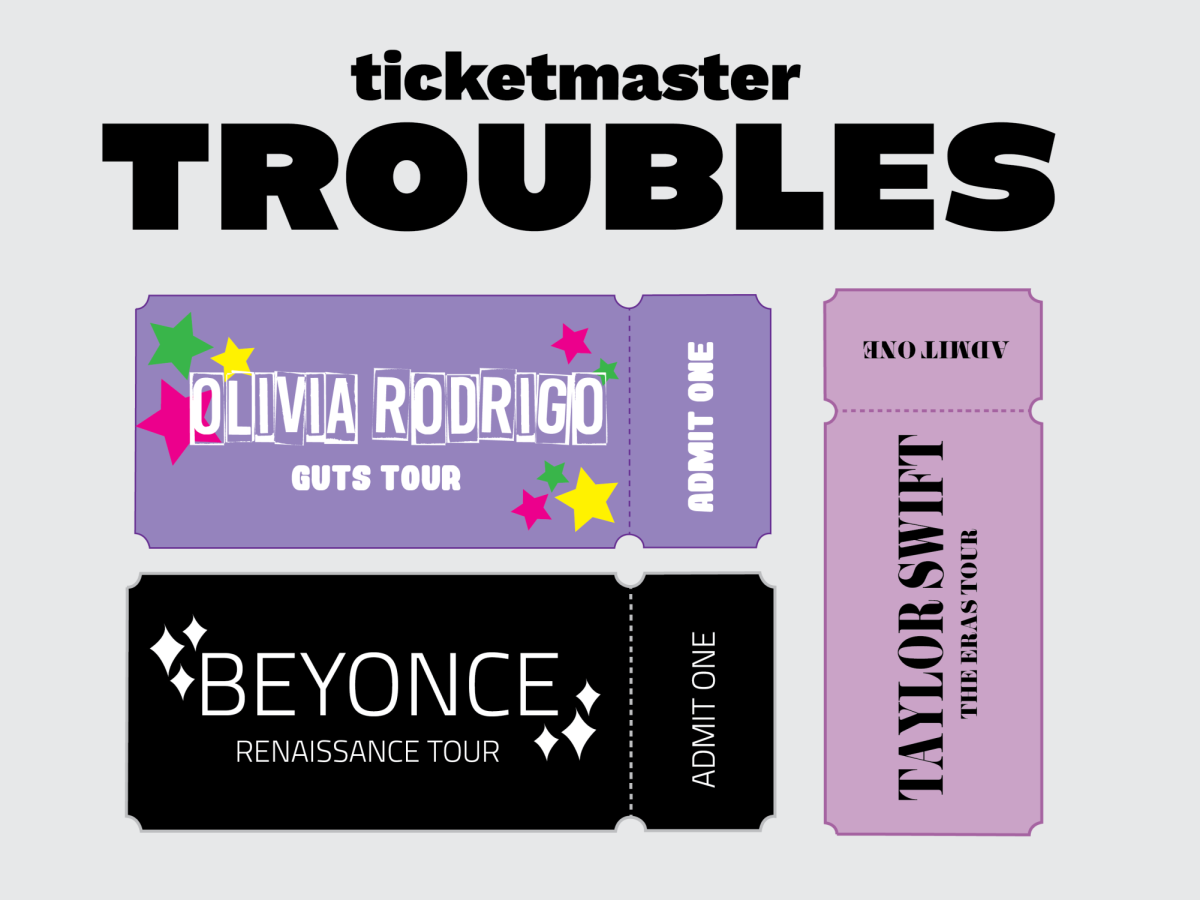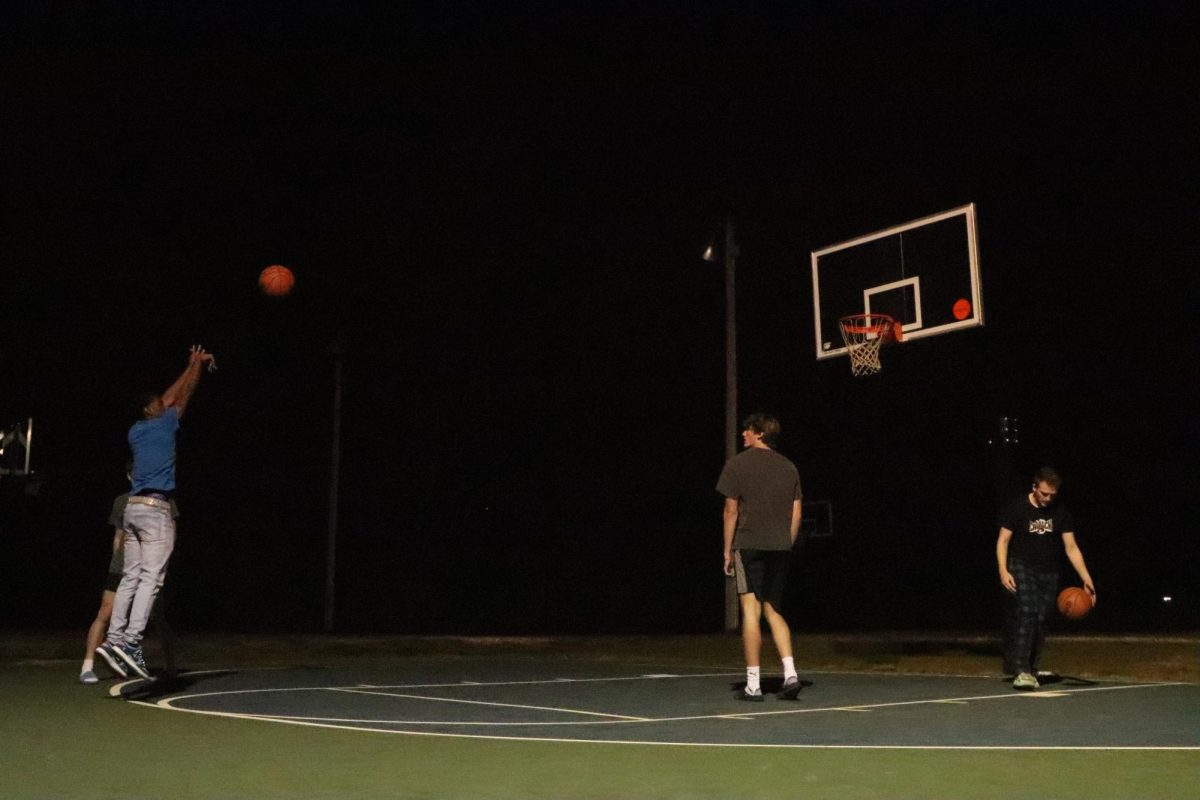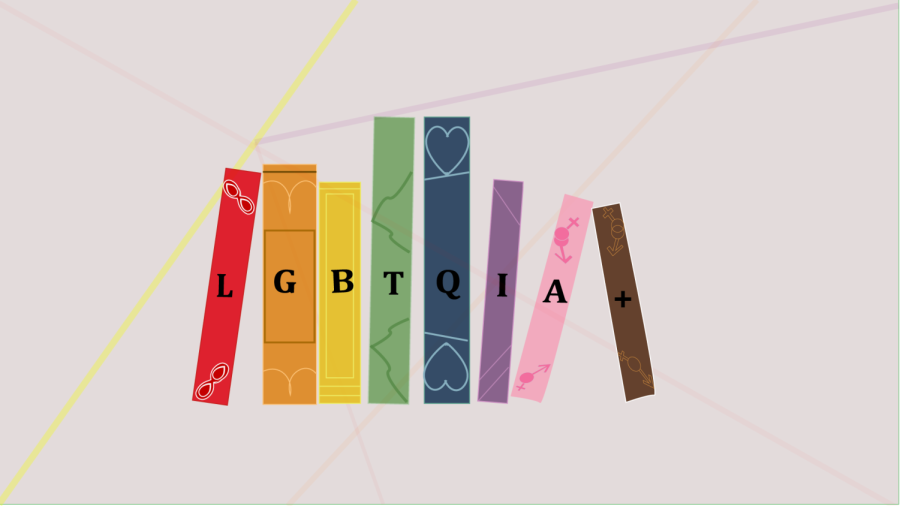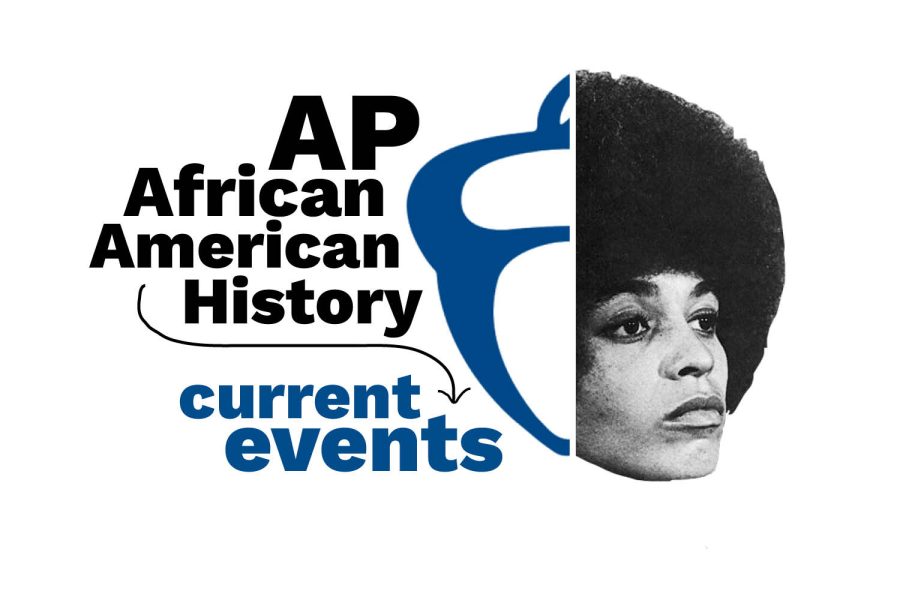Cold sweat ran from Paner’s brow down to his hands and dripped off the top of Louisville’s abandoned ice factory onto Shelby Street below. He would have wiped the distraction away, but his fists were locked in a hard grip, holding his friend Soare by the shins — upside down.
Soare’s face reddened as he tried to keep still, driving a paint roller down the wall, nose scraping against the building’s weathered brick carapace. He hoped the drastic transformation would be worth the risk.
“We had gotten on the top, and I was literally hanging him by his legs, dangling off this 20-story building,” said Paner, the alias of a 16-year-old graffiti writer from the group RCK, or River City Kids. “Everything is so quiet and then there’s just this little ambiance of just cars and the city going on under you while nobody has any clue that you’re up there.”
Soare, the alias of Paner’s older friend, introduced him to the world of graffiti. That night, Paner and Soare were bombing, another word for illegally painting “throw-ups” or “tags”—simpler works.
“That was the craziest place: the ice factory,” Soare said, “and we had a bunch of people there. It wasn’t really that late at night. It was about 10 p.m., which is too early to be doing that kind of stuff, but was someone gonna break their neck to see what we were doing up there?”
Paner and Soare won’t argue that what they do isn’t reckless, even insane, but such endeavors are part of their passion.
“Really it’s just a way to express myself,” Paner said. “I like the whole idea of it and just going out there and putting art on something that’s so bland.”
Graffiti is a risky process, and even if the writer isn’t hanging off of the side of a building, there is the constant threat of being arrested. The first time Paner and Soare were arrested together, Soare’s mother exploded at him.
“I don’t really like that story very much,” Soare said. “It was completely our fault; we were tagging in the middle of the day, and we knew we shouldn’t have been doing it. I had been painting for two years.”
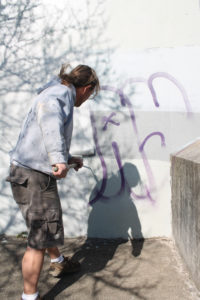
Paner, on the other hand, had only been writing graffiti for about two weeks.
“Next thing I remember is that we’re in a cop car, swearing up and down that we would never, ever, ever paint again, that we were gonna be good kids and stop writing,” Soare said.
He repeated this for his first few arrests, but still found himself captivated by the process and always returned to his spray cans.
“This is probably a really bad idea, but I don’t really care,” Soare said. “I wouldn’t recommend it. In the end, graffiti is immature. Still, my life would be a lot worse without it.”
Not all graffiti writers paint solely in the streets. Aemo, the alias for a 23-year-old legal and illegal graffiti writer in Louisville, has worked at venues ranging from concerts at universities to tour buses, but he always comes back to the alleys where he began.
“What he would do, I would do,” Aemo said, describing his high school experience with a friend who was already getting into graffiti. “He actually started sketching graffiti, and he knew some graffiti artists through the school itself, so when he started making graffiti, I said ‘Hey, that’s pretty cool.’ I had always looked at it, passing by, and I was always fascinated by it, because it poses questions. I just kind of picked up from there, and I’ve been painting ever since.”
Aemo’s reason for painting is ubiquitous across art forms: he does it for the sake of expressing himself.
“I paint for personal satisfaction,” Aemo said. “Not in the sense that I like destroying other people’s property, but more so that I like to see my name everywhere. I explained it to someone else, that me doing graffiti is my way of leaving a mark on society, when in a normal day I may not have left a mark.”
Whether some of this self-expression results in crime is hardly a question; however, Aemo does do a variety of legal pieces. When he profits from legal painting, Aemo often uses the money to invest in resources for more projects, buying different types of spray paint and nozzles to perfect his work and simultaneously growing his name.
Self-identified graffiti writer Riley Gregor (20) agrees with Aemo: graffiti is all about the artist’s legacy.
“Graffiti is more about yourself; it’s all about your ego, and the more you get it out there the more this false persona grows,” Gregor said. “It’s your alter-ego. They call it the Superman effect. You know, you’re Clark Kent during the day, and then at night you’re Superman, going around and no one can see you.”
Gregor has transitioned into a legal graffiti writer and has given seminars on the subject of graffiti and street art at North Carolina’s High Point University.
“I’ve heard people say that, ‘if you’re not bombing the street everyday, then you’re not a graffiti artist, you’re just an artist.’ I say it just depends on what you believe,” he said. “You can always keep being the kind of guy in back alleys, or take what you love off the street. And that’s your decision; that’s who you are.”
However, what most artists see as a major part of their lives, others call vandalism. Graffiti is, in most instances — save various legal walls or paid pieces — illegal and punishable in varying degrees. One of the most stinging punishments is the complete removal of a graffiti writer’s work.
The Graffiti Abatement Coalition of Louisville (GACL) is a “buff” organization, a group that recruits volunteers to paint over graffiti in Louisville. It urges members to “adopt the 48-hour gold standard for graffiti removal” and report graffiti if it remains un-buffed within that time frame. As stated by the GACL’s website, “Graffiti vandalism is a symptom and seed of urban blight.”
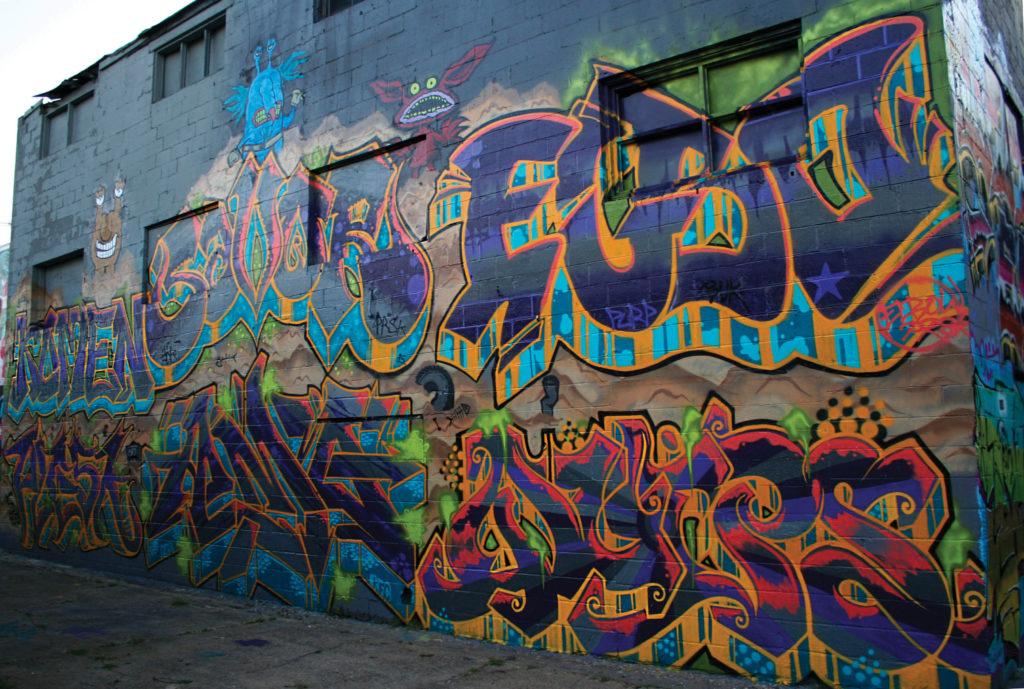
According to Aemo, “buffs,” a slang term for people who paint over graffiti, can be quite persistent in keeping the community clean and respectable. Aemo’s favorite tagging spot, a pole outside of Spinelli’s, keeps both sides of the conflict busy
“I love tagging on that pole,” he said, “because every single morning, the buff guy comes and paints over it. Every single morning. And every single day, and every single night, we write on it. It’s like an ongoing battle. I took a screwdriver to the pole the other day and chipped away the paint; the paint was about a centimeter thick.”
The game of tag continues all over Louisville. Some graffiti abatement workers, such as Ralph Weible, who is a part of Highlands Graffiti Abatement, go out nearly every day to remove or at least cover up the spraypainted tags thrown up the night before. Though he is paid through the Highland Commerce Guild to remove graffiti within a few of the city’s districts, he will often go outside of his allotted area to cover tags.
“It’s mostly civic pride. That’s why I go out in other areas that I’m not being paid to do,” Weible said. “If there was a way that I could get the entire city I would.”
Paner and Soare’s work on the ice factory was painted over within a week.
“It really sucks to see something you spent hours on taken down the next day, but that’s usually what happens,” Soare said. “You can’t paint somewhere in the Highlands. You’ve got to find an abandoned building, else it’ll be gone immediately. It’s part of the experience of being a graffiti writer.”
But the experience, as it turns out, can be expensive. Paint and other art supplies aren’t cheap. Soare found a way around this obstacle.
“I’ve been stealing it for about four or five years. They have a budget for theft,” Soare said in regard to large department stores. “Once you have a budget for theft, you’re fine. It was only last week I started buying paint and it’s expensive. Pretty soon I’ll go back to taking it.”
On the other hand, according to a July 2015 WFPL article by Jacob Ryan citing Louisville Metro Parks data, “vandals” caused more than $400,000 in damages at Louisville parks and community centers from 2010 to 2015.
Despite the price tag that comes with graffiti, this “alter-ego” can prove to be lucrative, as well. According to the New York Times, Banksy, a popular street artist, sold a work called “Slave Labor (Bunting Boy)” for $1.1 million in 2013. Banksy has been the forefront of graffiti’s mainstream acceptance, even creating a street art-inspired exhibit and “bemusement” park called “Dismaland.” Other writers, such as Louisville’s “Brrr,” made names for themselves simply by tagging their aliases so much that entire cities become aware of their presence.
In 2014, Sharon Scott, the owner of ARTxFM, actually showcased some of Brrr’s work in a street art exhibit called “Radio Waves and Escalades.” According to Scott, about 800 to 1,000 people passed through in the approximately two months the show was open.
“I believe street art has the ability to beautify areas, though a lot of people think it’s vandalism and that we shouldn’t be glorifying vandalism with art gallery space,” Scott said. “I tend to think differently.”
Scott specifically noted the positive community effects of graffiti and street art.
“It can bring attention to areas that need assistance,” she said. “Our artists aren’t the guys who paint on houses and businesses; they tend to paint on abandoned property. I think that’s a greater contribution to our community than most spray paint art, as it may say that this building needs some help.”
A recent death in the graffiti scene brings to light just how passionate not only writers themselves are about graffiti, but also Louisville community as a whole. Last November, Jonathon Brown, an internationally-known Louisville graffiti artist better known as “2Buck,” died while painting in Puerto Rico, but his family lacked the money to ship his body back to the United States. Brian Gaughan, owner of Spinelli’s pizza, organized a memorial and art show that raised money, all of which went to help 2Buck’s family, and LEO Weekly reported that popular Louisville graffiti writers such as Brrr, friends, and fellow artists from as far away as California came out to support the event.
“It was awesome how they reacted,” Paner said, describing how the community came together to recognize the writer and support his family. “I don’t know if he knew it or not, but he was making this huge impact on graffiti in today’s history as it is.”
Indeed, 2Buck succeeded in altering the graffiti stage in Louisville, taking on projects more dangerous than other artists could even dream of. He kickstarted an interest in graffiti for some, and he raised the standards for others.
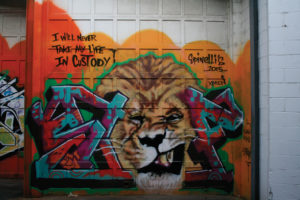
“Without 2Buck in Louisville,” Paner said, “I don’t know if the graffiti scene would even be what it is, to be honest.”
While graffiti was on the rise throughout Louisville during 2Buck’s golden days, no one broke the mold quite like he did, says Paner.
“There were a couple of kids who were in 2Buck’s generation who were doing some things, but 2Buck literally crushed everything. He did a whole new thing with graffiti in Louisville,” Paner said. “He was hitting massive spots, ridiculous like ‘How did you even get up there? How did you paint that big? How did you not die? How did you not get caught?’”
Graffiti writer or not, it is difficult to argue that 2Buck did not have a lasting significance in the Louisville graffiti scene, as well as other cities around the world. His death was extremely sudden for some, but others view it as a predictable fate.
“I thought it was big. I thought it was a lot. It was the most random thing,” Paner said, describing 2Buck’s death, but recognizing the consequences of such a risky exercise. “It happens, you know; I mean, you know what you’re doing up there. A lot of things can happen. It’s definitely not the safest thing to do.”
However, 2Buck’s commitment to his work is arguably a virtuous attribute, exemplifying determination and fearlessness.
“You’ve got to have a tremendous influence on people to go out to do the next thing,” Paner said. “Do whatever you want, to just try and not give up, to be ambitious, to have that drive to do whatever.”
Of course, that’s looking past the fact the source of 2Buck’s dedication is an illegal action, which some people find doable. Mary Carothers, a Professor of Fine Arts at the University of Louisville, goes so far as to praise the potentially perilous act of writing graffiti.
“It’s an art, really,” Carothers said. “These big pieces of spray paint art, which are more consciously drawn, and wheat paste pieces … which Banksy is famous for, … you see more of a refined taste that may have stemmed from the same intentions, like personal expression.”
Even Joshua White, founder of GACL, still considers graffiti an art form.
“It’s definitely an art. It’s a craft,” White said. “If you are a bomb-maker, there’s a real art in making bombs… there’s art and science mixed there and it does a lot of damage — we don’t tolerate it… but it’s an art.”
White became interested in the removal of graffiti in the early 2000s, when he began to notice an increasing amount of graffiti in the Highlands. Then in the fall of 2013, White found more near the intersection of Baxter and Chestnut.
“I started making calls through what I thought were the proper channels to get it removed and it didn’t. It didn’t go away,” White said. “I realized there’s no organization in Louisville, there’s no program, there’s no roadmap of any sort, there’s no leadership.”
Shortly after, White formed the GACL, which, according to White, “gets everybody that has a stake in the game to the same table and we get them talking and then come up with a plan to fix it.”
White sees the work he does as important to society, comparing Louisville to New York City where “they abandoned abatement.”
“Maybe 10 or 20 percent of the stuff that got produced was incredible,” White said. “The other 80 percent that was present was terrible and the entire neighborhood in that area took a hit — there was tagging, and there was higher crime in that region of the city.”
Greater Louisville Incorporated spokesman Tyler Glick said, “Graffiti can be a negative when site selectors come to our city seeking to locate jobs. Economic development officials typically view an abundance of graffiti as a negative.”
In addition to being a downside for prospective businesses, Glick noted that companies already functioning in Louisville face the perpetual threat of vandalism.
“Individual business owners who are victims of graffiti have to pay for removal. There are definitely business costs that come with graffiti,” he said.
In addition to the risks and disadvantages it holds in society, graffiti has severely impacted Paner and Soare’s personal lives, which revolve around painting.
“It caused a lot of stress in my family for a while, because I was just so young. They were worried,” Soare said. “It’s all I ever wanted to talk about. It’s all I ever wanted to do.”
“The only thing that changed with my parents is that they’re kind of mad at all the writing on the walls,” Paner said. “My family really kind of never knew what exactly I was doing. Ever. I think they still don’t.”
Paner is 16 years old — a student — and graffiti has not only had an effect at home, but it has also impacted his school life.
“All I do is draw and write on stuff. I don’t even do it intentionally,” Paner said. Writing on school walls has proved to be a difficult habit to break.
“I have a little pen in my pocket, I’ll just be sitting in the hall and I’ll just start writing,” Paner said. “I don’t even think about it.”
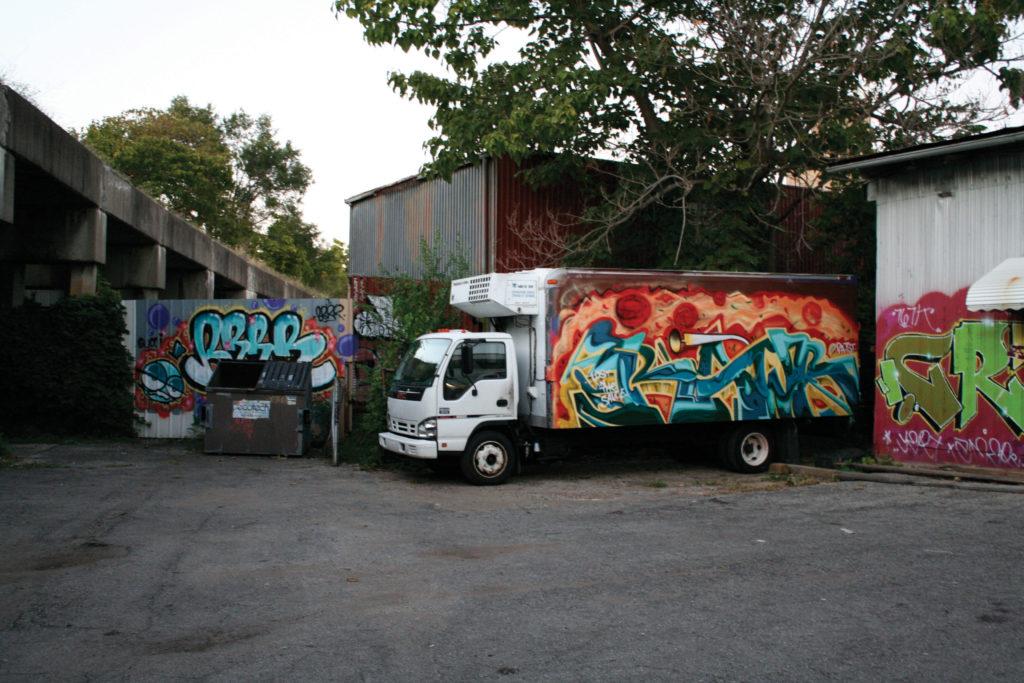
Similarly, the time commitment has taken its toll.
“I’m late for everything because of a lot of things, including graffiti,” Paner said. “I have problems with my attendance at school because of it.”
However, graffiti is a part of Paner’s and Soare’s lives, and they have chosen to accept it — the good and the bad — hoping to continue painting throughout their lives.
“I know that I can’t make a living off graffiti,” Soare said. “I am going to at least try to find something to do with art. You know there’s really not much money in it unless you really do it.”
Paner, likewise, wants to keep painting in the future, but he has other plans as well — bigger plans. He wants to attend the University of Louisville and go into business, marketing, and networking.
“No one’s telling me to do this,” Paner said. “It’s just because I want a better life for myself. It’s what I want.”


